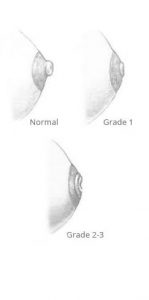In my High School, the Senior Prefect (SP) stood in the bathroom with fellow ladies having their bath together. Suddenly, a lady asked her: SP why are your nipples different from ours? How do you mean? The SP asked. The lady said: All our nipples are pointing outwards, yours is inwards and it looks weird! Are you sure you do not have cancer?
SP was astonished, she ran out of the bathroom and for the first time, took a good look at her breasts, and then her nipples. Yeah, it was different, but do I have cancer or anything she asked herself and was really scared.

Advertisement
Soon, it was time for her medical check-up. She met a doctor and asked her about her nipples. The doctor said it was fine, it just needed some little work and it would be normal. She explained to SP that she had Inverted Nipples. It was really the SP’s first-time hearing this! Although she was relieved that she did not have cancer, she was curious about having an inverted nipple. This curiosity made her asked for solutions to make it normal.

Image credit: moneyrf.com
Inverted nipples are nipples pointed inwards instead of outwards. It usually manifests during the teenage years when the development of breasts is rapid and continues to adulthood, but it is usually congenital (present from birth).
If a previously normal nipple becomes inverted with symptoms like tenderness, pain, and discharge, then it could indicate serious health conditions that need urgent medical attention. Visit the hospital immediately.
Grades of Inverted Nipples
Knowing the grade of your inverted nipples will give you an advantage on what technique is most suitable for correcting it.
To do this, stand in front of a mirror without your shirt. Hold your breast at the edge of the areola between your thumb and forefinger a little behind your nipple and then press inwards, gently but firmly. The grade of nipple inversion can be assessed depending on the nipple’s response.
 Image credit: myfertilityguide.biz
Image credit: myfertilityguide.biz
[A: Normal nipple; B: Grade 1; C: Grade 2; D: Grade 3]
- Grade 1: The nipple moves outwards easily when light pressure is applied to the areola. When the pressure is removed, the nipple maintains its projection for few minutes before retracting.
This grade of nipples hardly interferes with breastfeeding as there is little to no extra connective tissue (fibrosis).
- Grade 2: The nipple moves outwards when light pressure is applied, although not easily, and retracts as soon as pressure is removed.
This grade of nipples would interfere with breastfeeding as there is a moderate degree of fibrosis, together with mild retraction of the lactiferous ducts.
- Grade 3: The nipple stays retracted and does not respond to light pressure. It does not move outward. This is the most severe form of an inverted nipple.

This grade of nipples makes breastfeeding impossible, as there is a significant degree of fibrosis and retracted lactiferous ducts. There may be the presence of rashes and infections in this grade of inversion.
 Image credit: Toronto cosmetic clinic
Image credit: Toronto cosmetic clinic
There is need to test both nipples. Both nipples may not be inverted.
FURTHER READING:
BREAST CANCER: All You Need to Know
EXCLUSIVE BREASTFEEDING AND AFRICAN MOTHERS

Ezike Nonye is a Pharmacist who completed her Bachelor degree from University of Lagos (B.Pharm). She is currently exploring digital marketing analytics as a novel field in Pharmacy practice while also interning at the Federal Medical Center (FMC) Abeokuta, Ogun State, Nigeria. She is a graphic designer, a blogger and an entrepreneur. She is passionate about creating new things from nature and believes that there is no limitation to what you can achieve. She is a Christian and loves writing and open to new ideas and skills.

